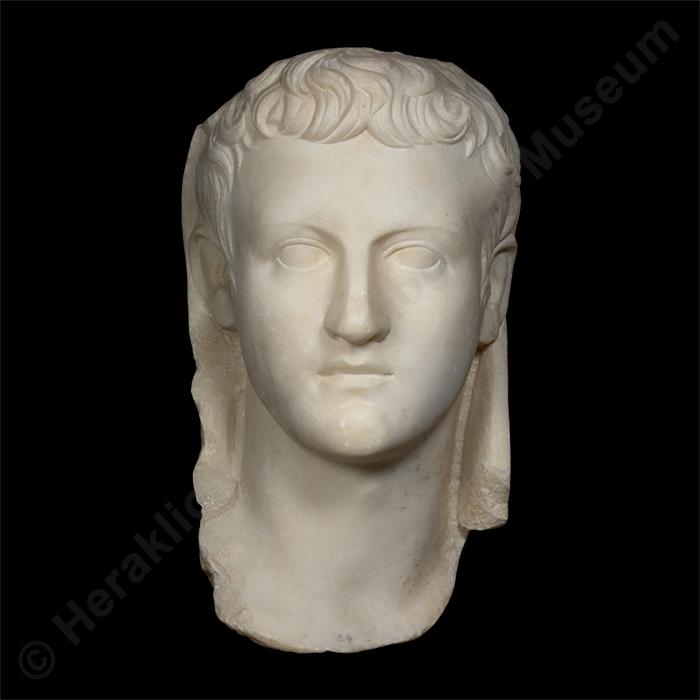Marble head of Emperor Caligula
Γ64
Stone (White marble)
Almost intact. Chipping to integral left side of toga. Toga chiselled away at top of head.
Height: 41 cm. Width: 23 cm. Thickness: 23 cm.
Gortyn
Area of the Agora
Roman period:
37-41 AD:
Gallery:
XXVIICase:
Not in caseExhibition thematic unit:
Sculpture. Hellenistic period (3rd-2nd c. BC) Roman period (1st c. BC-3rd c. AD)The art of portraiture
Description
Portrait statue of the Emperor Caligula (37-41 AD), sculpted in life size together with the neck and part of the toga, ready for insertion in a typical standing togatus statue of a Roman official or the emperor himself. The toga covers part of the head (capite velato), its rich drapery falling down the whole body to the ankles. The sculptor, probably Cretan, renders the youthful features of the emperor (hairstyle, well-carved features, small mouth and characteristic chin, etc.) successfully, if rather coldly by Greek standards, with a slight turn of the head to the right. Caligula’s face is known from sculptures, coins and other contemporary forms of artistic expression. The back of the head is only roughly carved, presumably because it was not visible once the statue was in position.Bibliography:
L. Mariani, "Cretan Expedition VII. Statue of an Asclepiad from Gortyna, American Journal of Archaeology 1 (1897), 266ff., fig. 1, pl. 12, no. 1. Fr. Studniczkar, Archäologischen Anzeiger 1910, 533. F. Poulsen, Ikonographische Miscellen, Copenhagen 1921, 67 και 69, fig. 18. F.P. Johnson, American Journal of Archaeology 30 (1926), 161. R. West, Römische Porträt-Plastik, München 1933-1941, I, 201. L. Curtius, Mitteilungen des Deutschen Archäologischen Instituts, Römische Abteilung 50 (1935), 298, Anm. 1. V.H. Poulsen, Acta Archaeologica 17 (1946), 36. V.H. Poulsen, Acta Archaeologica 29 (1958), 180-1. B. M. Felletti Maj, Enciclopedia dell’arte antica II, 274. J. Ch. Balty, Monuments et mémoires (Foundation E. Piot) 53 (1963), 96 Anm. 6. N. Platon, A Guide to the Archaeological Museum of Heraklion, Athens 1964, 154. Bartels 1964, 48, 101 note 380. L. Fabbrini, Bollettino d'Arte, 49 (1964), 325 note 95. L. Fabbrini, Mitteilungen des Deutschen Archäologischen Instituts, Römische Abteilung 73-74 (1966-7), 141 Abb. 45,2 and 46,2 and 47,2. C. C. Vermeule, Imperial Art in Greece and Asia Minor, Cambridge, Mass. 1968, 177, 178, 195, 386 fig. 109A, 124. S. Alexiou, Οδηγός Αρχαιολογικού Μουσείου Ηρακλείου, Αθήνα 1968, 132. M. Clavel, Béziers et son territoire dans l'antiquité, Paris 1970, 498. A. Stavridis, Untersuchungen zu den Kaiserporträts in Griechenland, Berlin 1970, 22ff., 83, pl. 47,48. H. Jucker, "Caligula", Arts in Virginia 2 (1973), 19. Z. Kiss, L'iconographie des princes Julio-Claudiens au temps d'Auguste et de Tibère, Warschau 1975, 151, fig. 542-3. A. Datsoulis-Stavridis, Αρχαιολογικά Ανάλεκτα εξ Αθηνών 13 (1980), 113ff., Anm. 7. U. Hausmann, "Bemerkungen zur julisch-claudischen ikonopgraphie", Eikones. Studien zum griechischen und roemischen Bildnis. Festschrift H. Jucker, Bern 1980, 138. Α. Datsouli-Stavridi Α., "Τα ρωμαϊκά πορτραίτα του Μουσείου Ηρακλείου", Πεπραγμένα του Δ΄ Διεθνούς Κρητολογικού Συνεδρίου, Α2, Agios Nikolaos 1981, 582 pl. 191c. E. D. Hertel, Untersuchungen zu Stil und Chronologie des Kaiser-und Prinzenporträts von Augustus bis Claudius, Bonn 1982, 70, 278-9. Kat. 142. A. K. Massner, Bildnisangleichung. Untersuchungen zur Entstehungs-und Wirkungsgeschichte der Augustusporträts, 43 v. Chr. - 68 n. Chr. Das römische Herrscherbild IV, Berlin 1982, 111 Anm. 599. I.F. Sanders, Roman Crete. An Archaeological Survey and Gazetteer of Late Hellenistic, Roman and Early Byzantine Crete, Warminster 1982, 48. D. Böschung, Die Bildnisse des Caligula, Das römische Herrscherbild 1,4, Berlin 1989, 29, 32ff., 107, Kat. 1. H. R. Goette, Studien zu römischen Togadarstellungen, Mainz 1989, 34 Anm. 147c. Ch. B. Rose, Dynastic Commemoration and Imperial Portraiture in the Julio-Claudian period, Cambridge 1997, 152-3, cat. 85, fig. 194. Romeo - E. C. Portale, Gortina III. Le sculture, Padua 1998, 325ff. Kat. 7, Tav. 42. F. Havé-Nikolaus, Untersuchungen zu den kaiserzeitlichen Togastatuen griechischer Provenienz, Mainz 1998, 89ff. Nr. 7 Taf. 4,2. M. Lagogianni-Georgakarakos, Die römischen Porträts Kretas. Bezirk Heraklion, CSIR Griechenland 6, 1, Athen 2002, 49-50, Nr. 4, Taf. 4.Author:
K. S.Photographs' metadata
